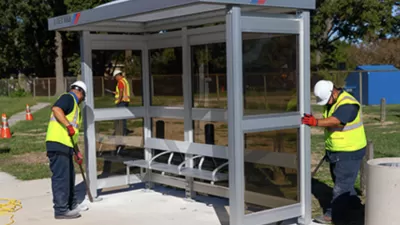In Washington state, King County Council will vote on a measure to adopt a new algorithm for transit service policy.
The proposed policy, recommended by the 28-member Regional Task Force, will determine a level of service that corresponds to ridership demand, which takes into account land use and population density. This is a complete overhaul of the existing policy that is based solely on political boundaries.
Scott Gutierrez of the Seattle P-I reports, "For the last decade, new bus service in King County was divided among three subareas according to the '40/40/20 rule.' That meant 40 percent of new service would go to suburbs in east King County; 40 percent would go to south King County; and 20 percent would go to Seattle. Seattle received the lowest share of new service, despite having the highest ridership demand."
Voting takes place in the next couple weeks.
FULL STORY: New Metro Service Plan: 'Era of the Empty Bus is Over'

Alabama: Trump Terminates Settlements for Black Communities Harmed By Raw Sewage
Trump deemed the landmark civil rights agreement “illegal DEI and environmental justice policy.”

Planetizen Federal Action Tracker
A weekly monitor of how Trump’s orders and actions are impacting planners and planning in America.

The 120 Year Old Tiny Home Villages That Sheltered San Francisco’s Earthquake Refugees
More than a century ago, San Francisco mobilized to house thousands of residents displaced by the 1906 earthquake. Could their strategy offer a model for the present?

LA’s Tree Emergency Goes Beyond Vandalism
After a vandal destroyed dozens of downtown LA trees, Mayor Karen Bass vowed to replace them. Days later, she slashed the city’s tree budget.

Sacramento Leads Nation With Bus-Mounted Bike Lane Enforcement Cameras
The city is the first to use its bus-mounted traffic enforcement system to cite drivers who park or drive in bike lanes.

Seattle Voters Approve Social Housing Referendum
Voters approved a corporate tax to fund the city’s housing authority despite an opposition campaign funded by Amazon and Microsoft.
Urban Design for Planners 1: Software Tools
This six-course series explores essential urban design concepts using open source software and equips planners with the tools they need to participate fully in the urban design process.
Planning for Universal Design
Learn the tools for implementing Universal Design in planning regulations.
Ada County Highway District
Clanton & Associates, Inc.
Jessamine County Fiscal Court
Institute for Housing and Urban Development Studies (IHS)
City of Grandview
Harvard GSD Executive Education
Toledo-Lucas County Plan Commissions
Salt Lake City
NYU Wagner Graduate School of Public Service




























